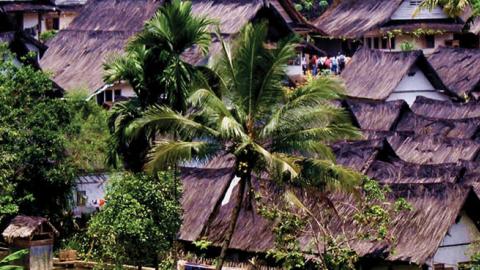(TRAVEL) The road from Garut to Tasikmalaya in West Java, Indonesia, is twisted and hilly, and often jammed by overloaded trucks spewing diesel fumes as they crawl up slopes at ten miles per hour. Here rest stops are frequent and welcome, especially for the truckers. About 15 miles east of Garut is one that looks like most of the others, with recovering drivers and others enjoying noodles, coffee, and pastries in the cafes and shops surrounding the muddy parking area.
But from the edge of this particular stop you can look down into the steep wooded valley of the Ciwulan river and at the beginning of a staircase down into the gorge. By my count there are 430 steps down, and roughly twice as many on the way back up. The stairs are the only access to a village below. It is hard going for out-of-shape outsiders to get there, though the locals often trek up and down several times a day.
The village is Kampung Naga and it is a world away from the hubbub above. Its houses are built of wood and bamboo in traditional thatched, gabled, Sundanese style. The 300 or so inhabitants do not use electricity, except for one battery-powered television on which they occasionally watch football (soccer). Given my birthplace, I was pleased to find that Liverpool had lots of supporters.
The mosque, also built in a Sundanese style, doesn’t use loudspeakers for the call to prayer, since there is no electricity. The call is instead announced, as in much of Java, by beating a large drum, a bedug, or a hollowed-out tree trunk, a tong-tong. For their imam, they choose someone from the village who has studied in a pesantren, an Islamic school, and when we visited they actually had two imams.
Pak Ucu, the Vice-Chief, told us that they try to respect both their environment and their traditions, which both constrict and guide the village’s development. It is bounded on two sides by the river, on one side by its rice fields and steep cliffs and on one side by a sacred forest.
The natives try to be self-sufficient in food—drawing on their rice fields, vegetable patches, chickens and goats. They also catch fish from the river and artificial fishponds. The fishponds are fed partially by the latrines built out over their banks, thus recycling human waste into edible protein. Although I knew that the villagers were healthy, I still passed on the fish at lunch.
The people of Kampung Naga do not reject modern technology per se but, like the Amish, first consider what adopting something new might mean for preserving their culture and community, for their natural surroundings, and for the teachings passed down to them by their forebears. People from outside may become part of the community by marriage, but they must commit to follow its traditions.
Children and growth
These boundaries mean that only a few people can live in the valley and this creates difficulties in raising and educating their children.
Pak Ucu stressed that their ancestors taught that they should learn to read and write so that they wouldn’t be exploited by outsiders. In the 1980’s the children began to go to elementary school outside of the village. Later the government required further education and the children now go to vocational and other schools, and some onto university. Some children go to pesantren if they wish. Pak Ucu told us, “For myself, I asked my daughter to go to pesantren.”
Since the village can’t house the schools, students must go to nearby towns and live in boarding houses. Of course, after living elsewhere, many no longer want to follow the traditional ways and do not return. Anyway, there is simply not enough room for all who do want to return. As a result, most villagers now live outside. But they are still understood as villagers, even if they are far away. And, like many Indonesians, when there are important ceremonies and holidays, including pilgrimages to the great Ancestor’s forest grave, they endure endless traffic to return to what they regard as their real home.
A sacred forest
The villagers are not allowed to enter the sacred forest. Pak Ucu told us:
“Ya, near the river is hutan larangan, the sacred forest. Almost nothing can be taken from the forest. Our ancestors taught ‘If you have something for medicine in the forest you can take it from there on one condition. You can put one leg in the forest but must leave one leg still in the river. If you are able to do that, then you can take from the forest. Otherwise it is forbidden.’ Even if a tree falls from the forest down across the river, nobody can take it. Even if people need the wood for building their house or for firewood, nobody can take from that forest.”
When we asked why the forest is sacred, he responded:
“We don’t know why exactly but according to the ancestors the forest is protected. The ancestors chose this place to live because there is a forest in front and forest behind. This is good for protection and good for the environment and for the air. I think the ancestors thought that if people were allowed to enter the forest, soon there would be no more forest. Everybody will cut it down and everybody will take it, for wood or medicine. We have a word in Sundanese referring to our instruction from the ancestors-- pamali. And people say, ‘Pamali go there’ and ‘Pamali take something from there.’ Pamali is taboo and the people never ask, ‘Why is pamali?’”
We inquired, “What would happen if someone took something from the forest? What would happen if someone went there?” He replied “Never. We have the philosophy from the ancestors… I mean if we break it, something will happen.”
Why keep these traditions?
Pak Ucu added that they don’t know the reasons for some of their traditions, or even when their community was founded. Their historical records were destroyed in 1956, when the radical Islamist group Darul Islam burned the village because they did not think it was properly Muslim.
“According to Darul Islam we were contravening true Islam. But my grandfather, a former village chief, went to a pesantren and was able to read and write in Arabic, and always sought to follow Islam. Darul Islam itself was different from most other Muslims, and it burned many other villages as well. There was another reason that they attacked the villages--because politically nobody supported them. People from the village obeyed the government not the Islamist rebellions.”
Even though they no longer have the documents from their past, they have messages left by their ancestors, and a key instruction was to follow their tradition.
Pak Ucu also stresses:
“We are Muslim but we keep the traditions, what our ancestors did, we need to do it forever…. There is nothing we do that is unIslamic. We follow the Muslim rule, we have our mosque and imam, we pray. But we also do what the ancestors did. And I feel and I think that there is no contradiction between being Muslim and being traditional.”
“Our life has a good connection to Islam. For instance, what we do to protect the environment, like it is mentioned in the Al-Quran. Everything that we do in the village is mentioned in the Al-Quran. But the people here in the village, especially here the leadership, don’t know what is exactly in the Al-Quran. But we believe it is good for Islam and there is no contradiction.”
Read in Religion Unplugged



















